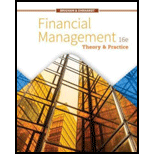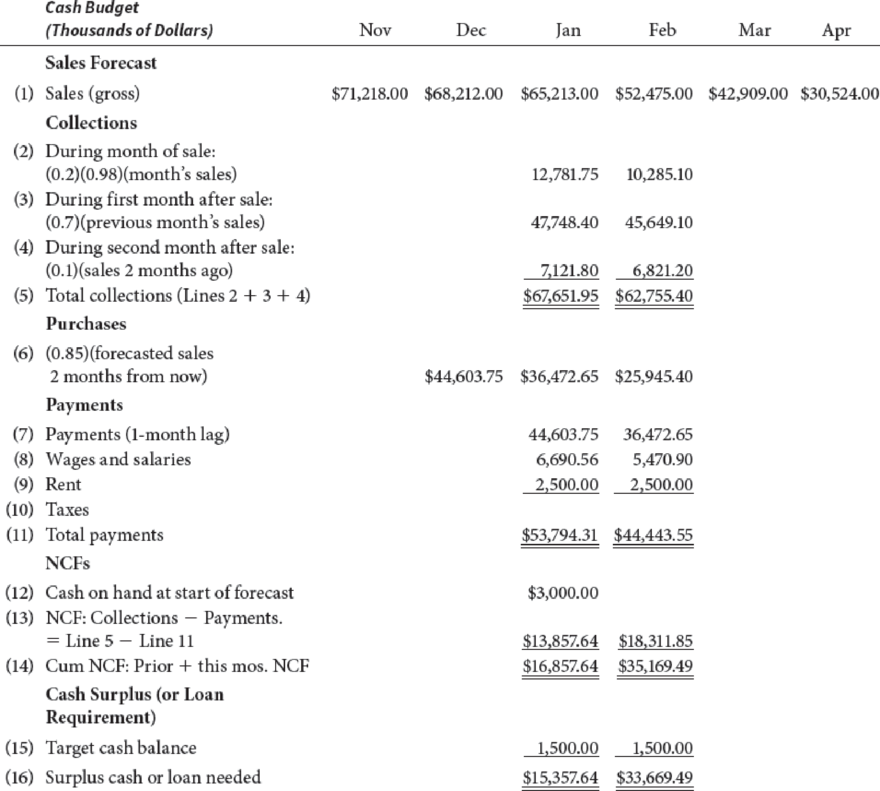
FINANCIAL MANAGEMENT
16th Edition
ISBN: 9781337902601
Author: Brigham
Publisher: CENGAGE L
expand_more
expand_more
format_list_bulleted
Concept explainers
Textbook Question
Chapter 16, Problem 16MC
In an attempt to better understand RR’s cash position, Johnson developed a cash budget for the first 2 months of the year. She has the figures for the other months, but they are not shown. After looking at the cash budget, answer the following questions:
- 1. What does the cash budget show regarding the target cash level?
- 2. Should
depreciation expense be explicitly included in the cash budget? Why or why not? - 3. What are some other potential
cash inflows besides collections? - 4. How can interest earned or paid on short-term securities or loans be incorporated in the cash budget?
- 5. In her preliminary cash budget, Johnson has assumed that all sales are collected and thus that RR has no
bad debts . Is this realistic? If not, how would bad debts be dealt with in a cash budgeting sense? (Hint: Bad debts will affect collections but not purchases.)

Expert Solution & Answer
Want to see the full answer?
Check out a sample textbook solution
Students have asked these similar questions
The Fortune Company is considering a new investment. Financial projections for the investment are tabulated below. The corporate tax rate is 24 percent. Assume all sales revenue is received in cash, all operating costs and income taxes are paid in cash, and all cash flows occur at the end of the year. All net working capital is recovered at the end of the project.
Year 0
Year 1
Year 2
Year 3
Year 4
Investment
$ 28,000
Sales revenue
$ 14,500
$ 15,000
$ 15,500
$ 12,500
Operating costs
3,100
3,200
3,300
2,500
Depreciation
7,000
7,000
7,000
7,000
Net working capital spending
340
390
440
340
?
What are the six types of alternative case study compositional structures (formats)used for research purposes, such as: 1. Linear-Analytical, 2. Comparative, 3. Chronological, 4. Theory Building, 5. Suspense and 6. Unsequenced. Please explain
For an operating lease, substantially all the risks and rewards of ownership remain with the _________.
QuestFor an operating lease, substantially all the risks and rewards of ownership remain with the _________:
A) Tenant
b) Lessee
lessor
none of the above
tenant
lessee
lessor
none of the aboveLeasing allows the _________ to acquire the use of a needed asset without having to make the large up-front payment that purchase agreements require
Question 4 options:
lessor
lessee
landlord
none of the above
Chapter 16 Solutions
FINANCIAL MANAGEMENT
Ch. 16 - Define each of the following terms:
Working...Ch. 16 - What are the two principal reasons for holding...Ch. 16 - Prob. 3QCh. 16 - Prob. 4QCh. 16 - Prob. 5QCh. 16 - Prob. 6QCh. 16 - Prob. 7QCh. 16 - Prob. 8QCh. 16 - What kinds of firms use commercial paper?
Ch. 16 - Prob. 1P
Ch. 16 - Medwig Corporation has a DSO of 17 days. The...Ch. 16 - What are the nominal and effective costs of trade...Ch. 16 - Prob. 4PCh. 16 - Prob. 5PCh. 16 - Snider Industries sells on terms of 2/10, net 45....Ch. 16 - Calculate the nominal annual cost of trade credit...Ch. 16 - Captain Whitman Ship Supplies offers terms of...Ch. 16 - Grunewald Industries sells on terms of 2/10, net...Ch. 16 - The D.J. Masson Corporation needs to raise...Ch. 16 - Negus Enterprises has an inventory conversion...Ch. 16 - Prob. 12PCh. 16 - Payne Products had 1.6 million in sales revenues...Ch. 16 - Dorothy Koehl recently leased space in the...Ch. 16 - Prob. 15PCh. 16 - Prob. 16PCh. 16 - The Raattama Corporation had sales of 3.5 million...Ch. 16 - Start with the partial model in the file Ch16 P18...Ch. 16 - Prob. 1MCCh. 16 - Prob. 2MCCh. 16 - Prob. 3MCCh. 16 - Is there any reason to think that RR may be...Ch. 16 - Prob. 5MCCh. 16 - Johnson knows that RR sells on the same credit...Ch. 16 - Prob. 7MCCh. 16 - Prob. 8MCCh. 16 - What is the impact of higher levels of accruals,...Ch. 16 - Assume that RR purchases $200,000 (net of...Ch. 16 - Prob. 11MCCh. 16 - Prob. 12MCCh. 16 - Prob. 13MCCh. 16 - Prob. 14MCCh. 16 - Prob. 15MCCh. 16 - In an attempt to better understand RR’s cash...
Knowledge Booster
Learn more about
Need a deep-dive on the concept behind this application? Look no further. Learn more about this topic, finance and related others by exploring similar questions and additional content below.Similar questions
- How has AirBnb negatively affected the US and global economy? How has Airbnb negatively affected the real estate market? How has Airbnb negatively affected homeowners and renters market? What happened to Airbnb in the Tax Dispute in Italy?arrow_forwardHow has AirBnb positively affected the US and global economy? How has Airbnb positively affected the real estate market? How has Airbnb positively affected homeowners and renters market?arrow_forwardD. (1) Consider the following cash inflows of a financial product. Given that the market interest rate is 12%, what price would you pay for these cash flows? Year 0 1 2 3 4 Cash Flow 160 170 180 230arrow_forward
- Explain why financial institutions generally engage in foreign exchange tradingactivities. Provide specific purposes or motivations behind such activities.arrow_forwardA. In 2008, during the global financial crisis, Lehman Brothers, one of the largest investment banks, collapsed and defaulted on its corporate bonds, causing significant losses for bondholders. This event highlighted several risks that investors in corporate bonds might face. What are the key risks an investor would encounter when investing in corporate bonds? Explain these risks with examples or academic references. [15 Marks]arrow_forwardTwo companies, Blue Plc and Yellow Plc, have bonds yielding 4% and 5.3%respectively. Blue Plc has a credit rating of AA, while Yellow Plc holds a BB rating. If youwere a risk-averse investor, which bond would you choose? Explain your reasoning withacademic references.arrow_forward
- B. Using the probabilities and returns listed below, calculate the expected return and standard deviation for Sparrow Plc and Hawk Plc, then justify which company a risk- averse investor might choose. Firm Sparrow Plc Hawk Plc Outcome Probability Return 1 50% 8% 2 50% 22% 1 30% 15% 2 70% 20%arrow_forward(2) Why are long-term bonds more susceptible to interest rate risk than short-term bonds? Provide examples to explain. [10 Marks]arrow_forwardDon't used Ai solutionarrow_forward
- Don't used Ai solutionarrow_forwardScenario one: Under what circumstances would it be appropriate for a firm to use different cost of capital for its different operating divisions? If the overall firm WACC was used as the hurdle rate for all divisions, would the riskier division or the more conservative divisions tend to get most of the investment projects? Why? If you were to try to estimate the appropriate cost of capital for different divisions, what problems might you encounter? What are two techniques you could use to develop a rough estimate for each division’s cost of capital?arrow_forwardScenario three: If a portfolio has a positive investment in every asset, can the expected return on a portfolio be greater than that of every asset in the portfolio? Can it be less than that of every asset in the portfolio? If you answer yes to one of both of these questions, explain and give an example for your answer(s). Please Provide a Referencearrow_forward
arrow_back_ios
SEE MORE QUESTIONS
arrow_forward_ios
Recommended textbooks for you

 Managerial AccountingAccountingISBN:9781337912020Author:Carl Warren, Ph.d. Cma William B. TaylerPublisher:South-Western College Pub
Managerial AccountingAccountingISBN:9781337912020Author:Carl Warren, Ph.d. Cma William B. TaylerPublisher:South-Western College Pub Financial And Managerial AccountingAccountingISBN:9781337902663Author:WARREN, Carl S.Publisher:Cengage Learning,
Financial And Managerial AccountingAccountingISBN:9781337902663Author:WARREN, Carl S.Publisher:Cengage Learning, Survey of Accounting (Accounting I)AccountingISBN:9781305961883Author:Carl WarrenPublisher:Cengage Learning
Survey of Accounting (Accounting I)AccountingISBN:9781305961883Author:Carl WarrenPublisher:Cengage Learning Excel Applications for Accounting PrinciplesAccountingISBN:9781111581565Author:Gaylord N. SmithPublisher:Cengage LearningPrinciples of Accounting Volume 2AccountingISBN:9781947172609Author:OpenStaxPublisher:OpenStax College
Excel Applications for Accounting PrinciplesAccountingISBN:9781111581565Author:Gaylord N. SmithPublisher:Cengage LearningPrinciples of Accounting Volume 2AccountingISBN:9781947172609Author:OpenStaxPublisher:OpenStax College


Managerial Accounting
Accounting
ISBN:9781337912020
Author:Carl Warren, Ph.d. Cma William B. Tayler
Publisher:South-Western College Pub

Financial And Managerial Accounting
Accounting
ISBN:9781337902663
Author:WARREN, Carl S.
Publisher:Cengage Learning,

Survey of Accounting (Accounting I)
Accounting
ISBN:9781305961883
Author:Carl Warren
Publisher:Cengage Learning

Excel Applications for Accounting Principles
Accounting
ISBN:9781111581565
Author:Gaylord N. Smith
Publisher:Cengage Learning

Principles of Accounting Volume 2
Accounting
ISBN:9781947172609
Author:OpenStax
Publisher:OpenStax College
Responsibility Accounting| Responsibility Centers and Segments| US CMA Part 1| US CMA course; Master Budget and Responsibility Accounting-Intro to Managerial Accounting- Su. 2013-Prof. Gershberg; Author: Mera Skill; Rutgers Accounting Web;https://www.youtube.com/watch?v=SYQ4u1BP24g;License: Standard YouTube License, CC-BY